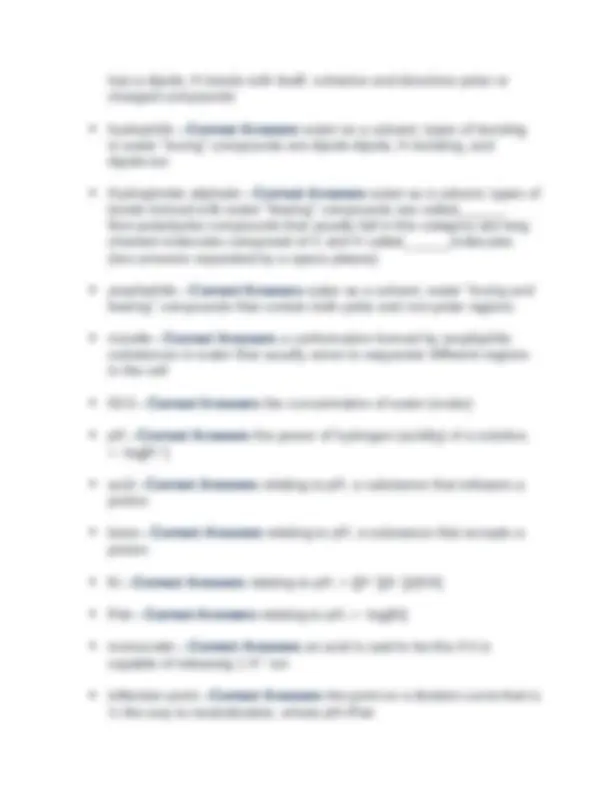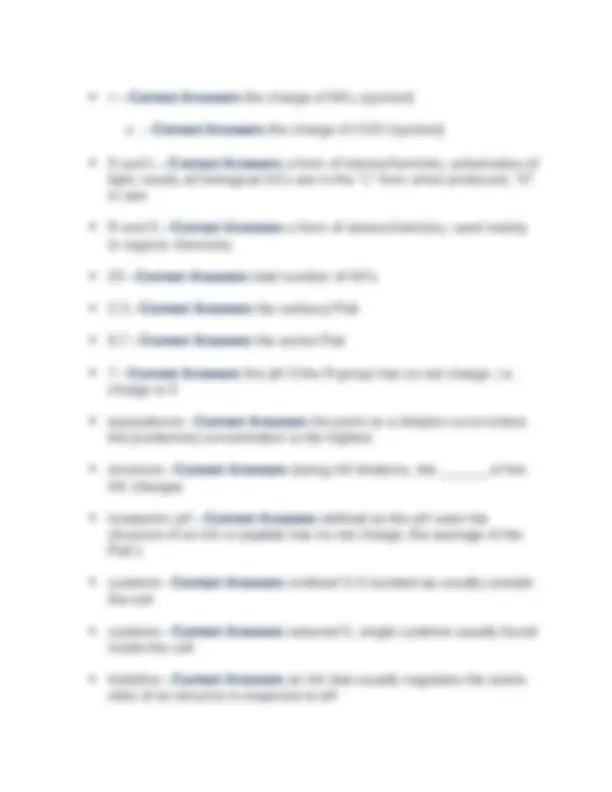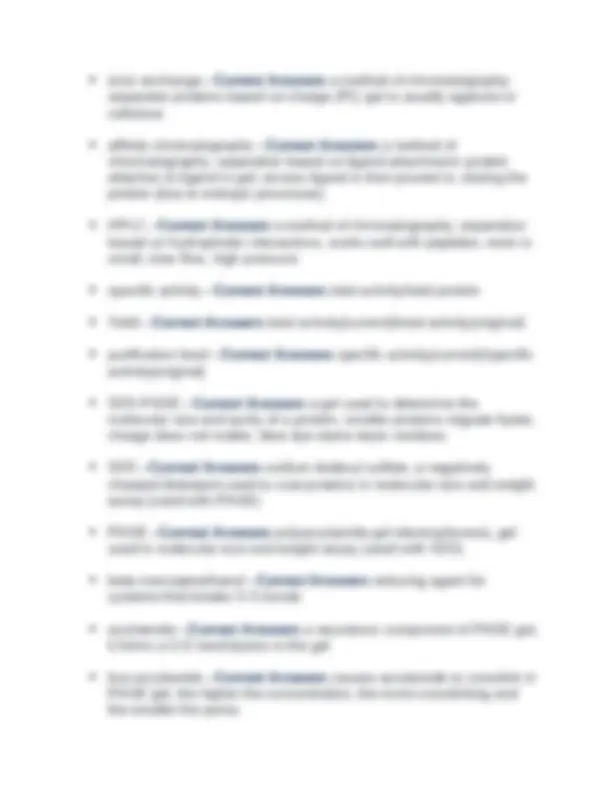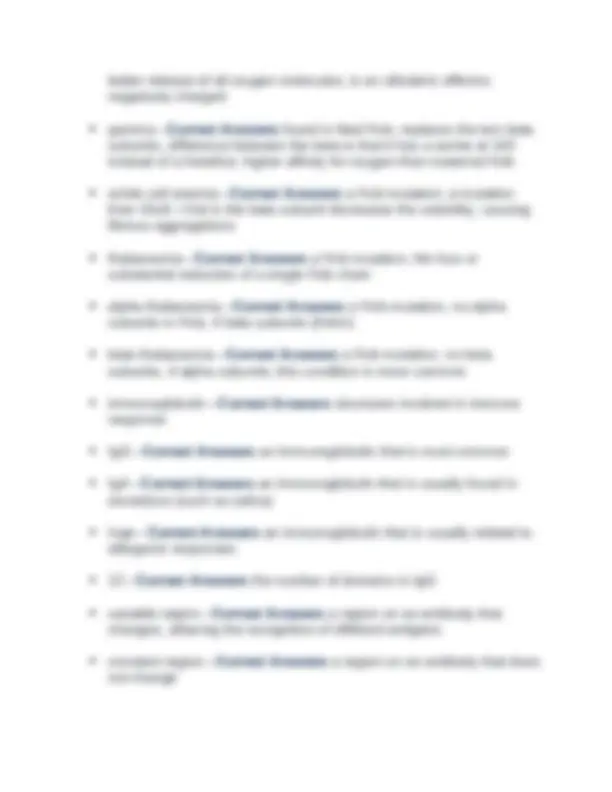











Study with the several resources on Docsity

Earn points by helping other students or get them with a premium plan


Prepare for your exams
Study with the several resources on Docsity

Earn points to download
Earn points by helping other students or get them with a premium plan
Community
Ask the community for help and clear up your study doubts
Discover the best universities in your country according to Docsity users
Free resources
Download our free guides on studying techniques, anxiety management strategies, and thesis advice from Docsity tutors
Biochemistry Test 1examination test with correct marking scheme
Typology: Exams
1 / 17

This page cannot be seen from the preview
Don't miss anything!










biochemistry - Correct Answers a discipline in biochemistry; is the description of molecules in biology/chemistry of proteins molecular biology - Correct Answers a discipline in biochemistry; the manipulation of DNA, genetics cell biology - Correct Answers a discipline in biochemistry; larger scale, functions and mechanisms within a cell/cell energetics cellulose - Correct Answers a natural polymer; found in plants for storage glycogen - Correct Answers a natural polymer; found in animals for storage protein - Correct Answers a natural polymer; tightly linked bonds nucleotide - Correct Answers a natural polymer; covalent bonds C,H,N,O,S - Correct Answers chemical elements commonly found in biochemistry carbon - Correct Answers an element commonly found in biochemistry, creates strong single or double bonds with very little rotation covalent - Correct Answers a chemical bond in biology; a pair of shared electrons, very strong, bonds between polymers, >1 bond per atom, flexible and alternate re-arrangement
non-covalent - Correct Answers a chemical bond in biology; weaker bonds, but additive, creates specificity, highly dynamic/transient bonds, required for molecular recognition electrostatic, hydrogen, van der wails, hydrophobic - Correct Answers 4 types of non-covalent interactions electrostatic - Correct Answers a non-covalent interaction; such as ionic bonds Na⁺ + Cl⁻ -> Nalco hydrogen - Correct Answers a non-covalent interaction; a H is shared between two electronegative atoms such as F,O, or N; the more electronegative atom pulls the electron closer, creating a dipole donor acceptor - Correct Answers the H bond _____ becomes more tightly linked, the H bond_____becomes less tightly linked (two answers separated by a space please) Van Der Waals - Correct Answers a non-covalent interaction; the interaction between molecules with temporary dipoles from fluctuating electrons, are weak but additive hydrophobic interaction - Correct Answers a non-covalent interaction; the clustering of these molecules in polar substances i.e. water interacts with itself and causes other non-polar residues to cluster biological solvent - Correct Answers roles of water; many organic and biological materials are able to dissolve in water part of reaction - Correct Answers roles of water; water is a common substance in biochemical reactions such as the cleavage of bonds regulation - Correct Answers roles of water; water is essential in regulating temperature and pH (the ideal temperature of water with the highest heat capacity is 37°C) water - Correct Answers a substance found in nearly all biological reactions and organisms; has a bond angle between H's of 104.5°,
polypro tic - Correct Answers an acid is said to be this if it is capable of releasing more than 1 H⁺ ion HH equation - Correct Answers the name of the following equation(remember equation too): pH=pKa+log([base]/[acid]) buffer - Correct Answers a substance that significantly (to ±1 pH unit) can control molecular structure and activity acetate and citrate - Correct Answers two natural buffers 8.3 - Correct Answers a synthetic buffer; the Pak of TRIS 7.5 - Correct Answers a synthetic buffer; the Pak of HEPES(a zwitterion) phosphate, proteins, carbonate - Correct Answers 3 cellular buffers (hint: first can be found at 1mM in blood, examples of the second are hemoglobin and albumen, the third is the most common) 7.4 - Correct Answers the pH of blood lungs - Correct Answers an organ that regulates blood pH zwitterion - Correct Answers compounds that have both a positive and negative charge on the same molecule but are neutral overall side chain - Correct Answers also known as the R-group amino, carboxyl, alpha carbon, r-group - Correct Answers the 4 general constituents of an AA AA - Correct Answers short form for Amino Acid chiral - Correct Answers the ∝-carbon is said to be this (it has 4 groups attached) enantiomers - Correct Answers also known as stereo isomers, the only AA that is not is glycine, where R=H
+ - Correct Answers the charge of NH₃ (symbol) o - Correct Answers the charge of COO (symbol) D and L - Correct Answers a form of stereochemistry; polarization of light; nearly all biological AA's are in the "L" form when produced, "D" is rare R and S - Correct Answers a form of stereochemistry; used mainly in organic chemistry 20 - Correct Answers total number of AA's 2.3 - Correct Answers the carboxyl Pak 9.7 - Correct Answers the amino Pak 7 - Correct Answers the pH if the R-group has no net charge. i.e. charge is 0 equivalence - Correct Answers the point on a titration curve where the [zwitterion] concentration is the highest structure - Correct Answers during AA titrations, the ______ of the AA changes Isoelectric pH - Correct Answers defined as the pH were the structure of an AA or peptide has no net charge; the average of the Pak’s cysteine - Correct Answers oxidized S-S bonded aa usually outside the cell cysteine - Correct Answers reduced S, single cysteine usually found inside the cell histidine - Correct Answers an AA that usually regulates the active sites of an enzyme in response to pH
simple - Correct Answers protein composition; a protein is said to be this if it is only composed of AA's (no other groups) conjugated - Correct Answers protein composition; a protein is said to be this if it contains AA's and other chemical groups (such as organics or metal ions) prosthetic group - Correct Answers protein composition; names of non AA groups found on conjugated proteins, cofactors/coenzymes covalently linked to protein globular - Correct Answers protein composition; a protein is said to be this if it is water soluble and found in the cytoplasm of cells fibrous - Correct Answers protein composition; a protein is said to be this if it is water soluble and found in the cell structure assay development - Correct Answers first step in protein isolation and purification source and lyse - Correct Answers second step step in protein isolation and purification fractional centrifugation - Correct Answers a protein isolation technique that separates the supernatant from the pellet supernatant - Correct Answers the liquid component left from a fractional centrifugation pellet - Correct Answers the more solid component separated from a fractional centrifugation chromatography - Correct Answers a protein isolation technique that separates proteins based on many characteristics gel filtration or molecular exclusion - Correct Answers a method of chromatography; separation based on size, large proteins elute first, small proteins elute later,
ionic exchange - Correct Answers a method of chromatography; separates proteins based on charge (PI); gel is usually agarose or cellulose affinity chromatography - Correct Answers a method of chromatography; separation based on ligand attachment; protein attaches to ligand in gel; excess ligand is then poured in, eluting the protein (due to entropic processes) HPLC - Correct Answers a method of chromatography; separation based on hydrophobic interactions, works well with peptides, resin is small, slow flow, high pressure specific activity - Correct Answers total activity/total protein Yield - Correct Answers total activity(current)/total activity(original) purification level - Correct Answers specific activity(current)/specific activity(original) SDS-PAGE - Correct Answers a gel used to determine the molecular size and purity of a protein, smaller proteins migrate faster, charge does not matter, blue dye stains basic residues SDS - Correct Answers sodium dodecyl sulfate, a negatively charged detergent used to coat proteins in molecular size and weight assay (used with PAGE) PAGE - Correct Answers polyacrylamide gel electrophoresis, gel used in molecular size and weight assay (used with SDS) beta-mercaptoethanol - Correct Answers reducing agent for cysteine that breaks S-S bonds acrylamide - Correct Answers a neurotoxic component of PAGE gel, it forms a 3-D mesh/pores in the gel bus-acrylamide - Correct Answers causes acrylamide to crosslink in PAGE gel, the higher the concentration, the more crosslinking and the smaller the pores
alpha helix - Correct Answers a secondary structure; rod-like, with R-chains branching out, stabilized by H bonds between N-H and C=O groups. 3.6 residues per turn with H bonding every 4 AA. 10- residues per turn is average, proline disrupts steric interactions and is usually found at the ends to prevent bonding beta sheet - Correct Answers a secondary structure; sheet-like, 2 or more interactions, small AA's are favored anti-parallel - Correct Answers the configuration of the more common beta sheets which form tighter H-bonds, which leads to smaller loops bends or loops - Correct Answers a secondary structure; reverses in the direction of the main chain, usually connects an alpha helix and beta sheet common bend - Correct Answers a secondary structure; known as a beta turn, connects different anti parallel sheets bend - Correct Answers a secondary structure; 4 residues with H- bonding between AA 1 and AA 4 loop - Correct Answers a secondary structure; longer bends which are usually >6 AAs alpha alpha motif - Correct Answers a super secondary structure; usually deals with DNA beta beta motif - Correct Answers a super secondary structure; a more common structure Greek key - Correct Answers a super secondary structure; 4 adjacent beta strands beta barrel - Correct Answers a super secondary structure; parallel beta strands connected with an alpha helix
collagen - Correct Answers a super secondary structure; a fibrous protein that contains a triple helix(super helix) high in proline and hydroxyproline, a non-conventional helix early events - Correct Answers first part of the protein folding pathway; the formation of secondary structure intermediate - Correct Answers second part of the protein folding pathway; formation of ionic bonds final - Correct Answers last part of the protein folding pathway; compaction of the protein in vivo - Correct Answers a biological process that occurs in its natural environment molecular chaperone - Correct Answers a folding accessory protein; binds unfolded proteins by "sheltering" exposed non-polar regions heat shock protein - Correct Answers a folding accessory protein; ensures that proteins do not de-nature at high temperatures heat, organic solvents, SDS, urea - Correct Answers the 4 causes of protein unfolding denaturation - Correct Answers the loss of protein function (as well as structure), can be renatured "in vitro" homotypic - Correct Answers a protein in which all the subunits are the same heterotypic - Correct Answers a protein in which the subunits are different 141 - Correct Answers the number of AA's on one alpha chain in hemoglobin 144 - Correct Answers the number of AA's on one beta chain in hemoglobin
better release of all oxygen molecules, is an allosteric effector, negatively charged gamma - Correct Answers found in fetal Hob, replaces the two beta subunits, difference between the beta is that it has a serine at 143 instead of a histidine, higher affinity for oxygen than maternal Hob sickle cell anemia - Correct Answers a Hob mutation; a mutation from Glu6-->Val in the beta subunit decreases the solubility, causing fibrous aggregations thalassemia - Correct Answers a Hob mutation; the loss or substantial reduction of a single Hob chain alpha thalassemia - Correct Answers a Hob mutation; no alpha subunits in Hob, 4 beta subunits (Hahn) beta thalassemia - Correct Answers a Hob mutation; no beta subunits, 4 alpha subunits; this condition is more common immunoglobulin - Correct Answers structures involved in immune response IgG - Correct Answers an immunoglobulin that is most common IgA - Correct Answers an immunoglobulin that is usually found in secretions (such as saliva) Inge - Correct Answers an immunoglobulin that is usually related to allergenic responses 12 - Correct Answers the number of domains in IgG variable region - Correct Answers a region on an antibody that changes, allowing the recognition of different antigens constant region - Correct Answers a region on an antibody that does not change
hypervariable loop - Correct Answers a structure found in the beta chains of immunoglobulin folds that allows for the recognition of different antigens hydrogen peroxide - Correct Answers a waste product which is detrimental to cells, it degrades on its own slowly and requires a high activation energy transition state - Correct Answers an unflavored state at the peak of the activation energy between reactants and products cofactor - Correct Answers enzymes; a second chemical entity (organic or inorganic) coenzyme - Correct Answers enzymes; usually organic or organometallic, does not a form a permanent part of the enzyme holoenzyme - Correct Answers enzymes; a complete complex of protein and cofactor Apo enzyme - Correct Answers enzymes; just the protein component in a holoenzyme Vo - Correct Answers enzyme kinetics; initial velocity, ([P]/time) at start of reaction, =(Vmax[S])/(Km+[S]) Vmax - Correct Answers enzyme kinetics; the maximum velocity for an enzyme Km - Correct Answers enzyme kinetics; Michalis constant Km=[S] - Correct Answers when Vo=KAMAX/ Vo=KAMAX/2 - Correct Answers when Km=[S] high Km - Correct Answers enzyme kinetics; is an uptight bond between enzyme and substrate, low affinity low Km - Correct Answers enzyme kinetics; is a tight bond between enzyme and substrate, high affinity
inhibition - Correct Answers an enzymatic process where an effector shuts down or reduces an enzymes activity; drugs and toxins exert their effects through this mechanism irreversible - Correct Answers enzymatic inhibition; covalent bonds permanently change an enzyme reversible - Correct Answers enzymatic inhibition; non-covalent bonding effectors stop enzymatic processes, the three general forms are competitive, non-competitive (pure and mixed), and uncompetitive competitive - Correct Answers enzymatic inhibition; where the effector resembles the substrate, binds to the active site, high [S] lessens the effect of the inhibitor, Vmax stays the same, Km is altered pure non-competitive - Correct Answers enzymatic inhibition; inhibitor and substrate bind to different sites; Km stays the same, Vmax changes mixed non-competitive - Correct Answers enzymatic inhibition; inhibitor and substrate bind to different sites; Vmax and Km changes uncompetitive - Correct Answers enzymatic inhibition; inhibitor binds to the ES complex, Km decreases and Vmax increases, locks the substrate in position allosteric - Correct Answers regulatory pathways are usually controlled by these class of enzymes; in addition, the first enzyme in the pathway is usually the regulatory one and of this type allosteric - Correct Answers in enzymes, binding or catalytic changes cause a conformational change elsewhere homotopic - Correct Answers enzymatic allosteric; where the substrate and the effector molecule are identical heterotrophic - Correct Answers enzymatic allosteric; where the substrate and the effector are different
MWC concerted model - Correct Answers allosteric regulation; enzymes can either be found in the TT or RR state, the effector molecule shifts the enzyme to one state (hybrid TR not possible) sequential model - Correct Answers allosteric regulation; enzymes can either be found going from TT->TR->RR, the TR hybrid is possible covalent modification - Correct Answers cellular enzyme regulation; modification via phosphorylation of Seer, Thru, Tyr or ubiquitination of Lys proteolytic cleavage - Correct Answers cellular enzyme regulation; some enzymes are synthesized in the inactive form, the zymogen is cleaved into the active state, this is an irreversible process isoenzyme - Correct Answers cellular enzyme regulation; enzymes that carry out the same reaction but have different kinetics, regulatory properties, forms of coenzymes, and distribution zymogen - Correct Answers cellular enzyme regulation; the term used to describe an enzyme formed in an inactive state that has to be cleaved in order to work